

Chuky joined us at Michigan after receiving his undergraduate degree at MIT. His thesis work focuses on the optimization of the trajectory and design of a hypersonic vehicle. He has been developing and improving a reduced-order, control-oriented model that determines the optimum trajectory for a trimmed X-43-like hypersonic vehicle that ascends to orbit and avoids the operability limit associated with engine flameout, which he computes. Chuky has been supported by AFRL, Wright Patterson AFB and he also has a University scholarship. He was born in California and enjoys tennis.

Chris completed his Masters degree work at the University of Missouri and is now supported by the AFRL-Michigan MAX center. For his Ph.D. research he is developing an unsteady, reduced-order model of engine unstart. Unstart problems occurred on a recent X-51 flight and on previous SR-71 Blackbird flights. He is applying his model to a ramjet-scramjet engine with an X-43-like hypersonic vehicle design. Chris uses his model to predict shock wave movement during engine unstart that leads to the spillage of air and reduced thrust. To make his model control-oriented, computations are accelerated by applying Proper Orthogonal Decomposition (POD) methods.

Aaron's Ph.D. thesis work focuses on the fundamental aspects of turbulent combustion; he is studying the new regime of exceptionally intense turbulence that is typical of jet engines and afterburners. Aaron applies laser imaging methods (formaldehyde, OH PLIF and PIV) to image the flame structure, the velocity field and turbulent eddies (from the vorticity data). He observes new flame structure in the distributed reaction regime when the turbulence intensity exceeds a critical value that he measures. Results are compared to theoretical predictions. Aaron did his undergraduate work at the University of Michigan and his graduate work is supported by AFOSR.

Robin joined Michigan after completing undergraduate studies at the University of Maryland; she has been awarded a prestigious NSF fellowship. Her thesis work, which is mentored by Profs. Gamba and Driscoll, involves high-speed imaging of unsteady shock wave-boundary layer interactions. She operates a Mach 2.75 wind tunnel along with laser imaging diagnostics to understand the physics that control the speed of shock movement during the unstart process.

Tim completed his undergraduate work at the University of Minnesota and is now doing Ph.D. thesis work to achieve high-repetition rate imaging of certain fundamental aspects of turbulent combustion. Kilohertz laser imaging methods (formaldehyde, OH PLIF and PIV) are being applied to visualize the unsteady, dynamic interactions between flames and turbulent eddies in the distributed reaction regime. The work is supported by AFOSR.

Yuntao is completing his Ph.D. thesis research on the subject of understanding combustion instabilities in a model gas turbine combustor. The jet engine industry now uses premixed devices in order to reduce pollutants but they can experience "growl" instabilities. He combines measurements of phase differences (between oscillations in pressure, velocity and flame motions) with a model of a Helmholtz resonator that is forced by the flame motions.

Patton joined the PACE group in 2009 after completing a Masters degree at Georgia Institute of Technology. He completed his Ph.D. research by studying a research model gas turbine combustor on a NAVY project and he is studying the basic physics of flame blowout and an acoustic-convective combustion instability. He also has worked with Jacob Temme to make phase-averaged PIV velocity measurements, pressure spectra and high speed movies in the GE-TAPS low NOx gas turbine combustor experiment. He accepted a post-doctoral position at Ohio State University.
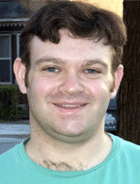
After graduating from The George Washington University in 2009, David joined the PACE group. He worked on an NSF-funded project to develop a novel new way to measure the Flame Index, which is a property of partially premixed combustion. His measurements are needed by recent advanced models of the partially premixed combustion that is found in gas turbine and scramjet devices. His process involves seeding fuel and air streams with tracer gases, then taking laser-induced fluorescence images to determine where the fuel and air are mixing. The measurements quantify the statistics of the premixed flame regions and the non-premixed flame regions. After completing his Ph.D. degree, David accepted a post-doctoral award to work at the Naval Research Laboratory in Washington D.C.

Derek Dalle obtained a B.S. in Mathematics and a B.A.E.M. in Aerospace Engineering and Mechanics from the University of Minnesota in 2008. He also received an M.S. from the Aerospace Department at the University of Michigan in 2010. Derek's research interests focus on the propulsion systems and flight dynamics of air-breathing hypersonic vehicles. His project is funded by the Michigan /AFRL Collaborative Center for Control Science. He has developed a gridless supersonic flow analysis program called SAMURI (Supersonic Aerodynamic Model Using Riemann Interactions) that is nearly as accurate as 2D CFD for non-reacting supersonic flows but takes orders of magnitude fewer computations. His other interests include basic numerics and memorizing a frightening amount of geography trivia. Derek accepted a position at NASA Ames in California.

Sean Torrez received his BS in Aerospace Engineering from MIT in 2007 and then he received his MS (AE) from UM in 2009. Sean's research has focused on modeling propulsion systems and combustion in high-speed flows. His project is funded by the Michigan /AFRL Collaborative Center for Control Science. The goals are to apply high-level design optimization and control methods to examine the performance of a hypersonic vehicle. This methodology would be applied early in the design process. Sean's contributions include the MASIV control-oriented model of a dual-mode ramjet-scramjet. MASIV includes a flamelet-based diffusion flame analysis submodel for jets in cross flow and a 1-D flow path solver that simulates ram-scram transition. His other interests include design philosophy, data presentation, and trees. He accepted a job in the area of design optimization at Brayton Energy, Inc., Hampton N.H.

Jacob Temme finished his undergraduate work at the University of Michigan and completed his Ph.D. thesis working on a GE Aviation funded study of Lean Premixed Prevaporized gas turbine combustors. His research interests include using PIV and PLIF to understand the complex flow field and mixing patterns that lead to the low NOx levels of LPP devices. He took high speed images of flame motions during an acoustic instability that is called engine growl. His work is identifying the physical processes that cause growl, and to provide measurements to improve future CFD models of engine combustion instabilities. He accepted a Post-doctoral research position at the University of Michigan.

Ethan came to Michigan in 2008 after completing an undergraduate degree from the University of Maryland. His Ph.D. work, jointly sponsored by the Collaborative Center for Aeronautical Science AFRL (Wright-Patterson AFB) and by Boeing, focused on how three dimensional flow caused by shock wave-boundary layer interactions(SBLI) affect the performance of rectangular supersonic inlets. His experimental design integrates vortex dynamics from three 'unit physics problems': a turbulent corner flow; a fin-plate junction and; near-wall shock curvature . Using diagnostics like stereo particle image velocimetry(stereo-PIV), Schlieren, and oil flow visualization has revealed a complicated 3D vortex footprint in the region of separation. Ethan analyzed the gathered high-resolution Stereo-PIV data to quantify this vortex-interaction region and is working closely with CFD modelers to understand how this flow mechanism might provoke growth of the unwanted boundary layer separation region and cause unstart in modern mixed compression inlets. In addition to research, Ethan has demonstrated a passionate commitment to effective pedagogy in the engineering classroom, winning both the Rackham and the College of Engineering Outstanding Student Instructor Awards. He accepted a post-doctoral award to work at Sandia National Laboratories, Combustion Research Lab, Livermore CA.

Matt completed his Ph.D. and is now working in at ISSI to develop a pulsed detonation igniter for the scramjet research program at Wright Patterson AFB. His Ph.D. thesis topic is related to isolator-combustor interactions that occur in a direct-connect ramjet-scramjet experiment that is funded by the NASA Hypersonics Program. He has been operating a Mach 2.2 wind tunnel that is connected to a ramjet-scramjet combustor. He uses kilo-Hertz repetition rate laser schlieren imaging to observe the unsteady shock wave patterns and how they are correlated to the downstream combustion of a hydrogen jet in a high speed cross-flow.

obtained his B.S. in Aerospace Engineering from the University of Virginia in 2002. He subsequently stayed on at UVA for his Masters and got an M.S. in Mechanical and Aerospace Engineering in 2003. Sulabh is studying the combustion at a fundamental level within a realistic model gas turbine combustor. The primary aim of his research is to investigate the reaction zone structure, chemistry, and its interaction with the flow field within a highly turbulent environment such as that of a gas turbine. To this end, the study utilizes relatively established laser diagnostic techniques such as PIV and CH PLIF and more recent techniques such as reaction rate imaging (through simultaneous PLIF of OH and CO). His thesis topic was: An Experimental Study of the Stable and Unstable Operation of an LPP Gas Turbine Combustor He received his Ph.D. degree in 2008 and now is a research engineer at Exxon Mobil Upstream Research in Houston Texas.

He received a B.S. in Aerospace Engineering from Georgia Tech in 2004 and an M.S.E. in the same from Michigan in 2006. He is a National Defense Science and Engineering Graduate Fellow as well as a National Science Foundation Graduate Research Fellow. He received his Ph.D. degree in 2010 and is a research engineer at Creare Inc. in Hanover New Hampshire. Danny's research interests included supersonic combustion and dual-mode scramjet engines. He also worked with modifying the supersonic combustion facility in order to study a fuel jet in a supersonic crossflow upstream of a flame-holding cavity. Advanced diagnostics such as planar laser induced fluorescence (PLIF), particle image velocimetry (PIV), and schlieren imaging were used in his research.

Alex received his B.S. in Aerospace Engineering from The Ohio State University in 2004 and a M.S.E in Aerospace Engineering from the University of Michigan in 2006. Alex’s Ph.D. thesis work focused on the coupling between fluid dynamic mixing and combustion at elevated pressures. These results are used in the development and verification of codes for rocket engine design. He studied the mixing of coaxial jets using acetone PLIF. Velocity, density and diameter ratios are varied to obtain mixing relations for the growth of the primary and secondary cores along with the stoichometric contour. The same will be done for reacting cases using OH PLIF. Alex is a research scientist at AFRL, Edwards CA and is conducting studies of the combustion within liquid-fueled rocket engines at high pressures. His thesis title was: An Experimental Investigation of Reacting and Nonreacting Coaxial Jet Mixing in a Laboratory Rocket Engine.

Adam joined the department in 2004 after receiving his B.A.Sc. in Aerospace Engineering from the Division of Engineering Science at the University of Toronto earlier that year. He received his M.S.E is Aerospace Engineering from the University of Michigan in 2006. Adam is the recipient of an NSERC Undergraduate Student Research Award and the Donald Matheson Springer Fellowship. His Ph.D. research provided an understanding of the fundamentals of turbulent combustion in order to facilitate combustion model development and engine design. Adam has developed a new Cinema Stereoscopic Particle Image Velocimitry (CS-PIV) system for use in turbulent combustion studies. This system is used to capture detailed movies of eddies interacting with a turbulent premixed Bunsen flame in order to better understand the dynamics of the flame front. His thesis title was: The Dynamics of Turbulent Premixed Flames: Mechanisms and Models for Turbulence-Flame Interaction. He received his Ph.D. degree in 2009 and accepted a post doctoral position at DLR in Stuttgart Germany. He joined the faculty at the University of Toronto as an Assistant Professor.

Ph.D. 2007 (co-chair with S. Ceccio, ME) Sherry is a Research Fellow in the Department of Biomedical Engineering at the University of Michigan.

Chad came to Michigan after completing his B.S. at Georgia Tech in Atlanta. He spent some time taking data in the Wright Patterson AFB supersonic combustor facility while enrolled at Michigan. His Ph.D. thesis was “An experimental study of flame stability in a directly-fueled wall cavity with a supersonic free stream.” He now is a research engineer at Exxon Mobil Upstream Research in Houston Texas. He works with stationary gas turbines to provide power for Exxon’s needs.

Jeff did his undergraduate work at North Carolina State University and completed a Ph.D. thesis at Michigan in 2005. The title was: Mixture fraction and scalar dissipation rate imaging in turbulent nonpremixed flames near extinction. He developed a new method to use laser induced fluorescence imaging (PLIF) to measure scalar dissipation rate in flames. Jeff then received an NRC post-doctoral award to do two years of research at Naval Research Laboratories in Washington DC. He now is an Assistant Professor of Mechanical and Aerospace Engineering at the Ohio State University. He recently won an AFOSR Young Investigator award, an NSF CAREER award, a distinguished paper award from The Combustion Institute, and an Outstanding Research Award from NRL.

Sergei completed a post-doc appointment at Purdue University then joined the research staff at Conoco-Phillips in Bartlesville OK. He conducts combustion studies, including multiphase simulation of entrained flow gasification.

Ansis completed post doctoral work at the Sandia National Labs Combustion Research Facility in Livermore CA, where he researched nontraditional fuels for low-temperature combustion in diesel engines. He then joined Honeywell Corp. in Tucson AZ where he did research to develop and patented a new sensor probe for use in operating gas turbine engine combustors.

Alfonso is a Senior Engineer in thermal sciences at Exponent Engineering, Maynard MA. Dr. Ibarreta is a principal member of the NFPA's Technical Committee on Explosion Protection Systems. He is a Certified Fire and Explosion Investigator and has investigated fires and explosions involving consumer products, residential and commercial buildings, and industrial facilities. He has researched changes in flammability of polymeric materials with thermal aging, and studied the ignition characteristic of solid and powder fuels. Prior to joining Exponent, he was a Senior Research Associate at Case Western Reserve University, in Cleveland, performing combustion research in NASA Glenn's 2.2 Second Drop Tower facility. He studied nearly extinguished flames for normal gravity and microgravity conditions.

Was a research professor of Physics, Mechanical and Aeronautical Engineering at the Naval Postgraduate School, Monterrey CA, where he conducted research on pulse detonation engines from 2001 - 2010. This led to many publications and his textbook on the subject: Pulsed and Continuous Detonations. He won the Outstanding Research Achievement Award, Naval Postgraduate School, in 2003. Jose now is an experimental physicist at Lawrence Livermore National Laboratory, Livermore CA. He is in the Initiation and Detonation Science group of the High Explosive Application Facility.
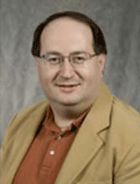
Al did his undergraduate work at California Institute of Technology and was awarded the FXB Fellowship at the University of Michigan, where he completed his Ph.D. thesis work in 2000. After a post doc appointment at Cal Tech, he was appointed as an Assistant Professor at the University of Iowa. His interests are: flame front dynamics; impact of fuel mixing on combustion instabilities; combustion of bio-derived fuels; droplet and spray dynamics, laser diagnostics; reacting and unsteady flows; combustion instability; reaction layer dynamics; high speed imaging.

Adrian received his Ph.D. in 1997 (co-chaired with W. Dahm). Now he is Director of Commercial Applications at XOJET near San Francisco. He has been involved in program management, operational management and solution architecture experience in e-commerce, cloud computing, business intelligence and enterprise integration across the aviation field.

He is now President of CPAST (Corporation for Public Access to Science and Technology) and system administrator for FHM Technologies in Berkeley, MI. Part of his job is to keep ForEST, an online encyclopedia of energy, running smoothly. He completed a postdoc in Prof. Richard Axelbaum's combustion lab at Washington University in St. Louis where he worked on combustion synthesis of nanoparticles. He was an adjunct professor of mechanical engineering at Washington University in St. Louis where he taught the class "Combustion and Environment".
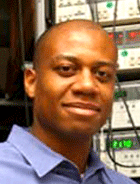
Rodney received his BS and MS degrees from the University of Maryland before completing his Ph.D. thesis at U. of Michigan in 1977. Rodney Bryant, Ph.D. 1997 Dr. Rodney A. Bryant is a mechanical engineer in the Fire Measurements Group of the Fire Research Division (FRD) of the Engineering Laboratory (EL) at the National Institute of Standards and Technology (NIST) in Gaithersburg MD. Dr. Bryant's research interests include the fluid dynamics of fire, measurement science as applied to the convective transfer of heat and mass, and measurement uncertainty. He directs research projects aimed at improving measurement methods to foster a better understanding of the fluid dynamics of fires and to reduce the risk of exposure to respiratory threats for first responders.

Jeff finished his BS work at the University of Cincinnati before enrolling at Michigan in the USAF Palace Knights program. He did two years of his Ph.D. thesis work in the scramjet facility at Wright-Patterson AFB in Dayton OH and completed his thesis in 1997. He then became a research scientist at the Advanced Propulsion Division of AFRL, WPAFB where he currently runs the scramjet supersonic propulsion facility. He also has served as an associate professor at Sinclair Community College in Dayton OH.
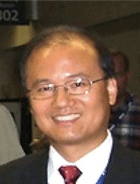
Hwanil received his BS degree from Seoul National University and his Ph.D. from Michigan in 1996. He is now a professor of Aerospace Engineering at Chungnam National University, Daejeon, Korea. His interests are: Aerospace Propulsion System Design, Advanced Combustion, Tactical Missile Propulsion, and Hypersonic Airbreathing Propulsion.

Chuck completed his BS degree at Miami University in Ohio before coming to Michigan. He received his Ph.D. degree in 1996. Chuck did a post-doc then joined the scientific staff at Sandia National Laboratory in Livermore CA, where he is currently located. He has developed a leading research program in the combustion aspects of diesel engines. For his work he received the Silver Medal from the Combustion Institute, the 2009 SAE John Johnson Award for Outstanding Research in Diesel Engines at the 2010 SAE World Congress Awards Ceremony, and numerous other awards for outstanding SAE papers. His research interests include fundamental studies of emissions from diesel engines operated on biodiesel fuel.
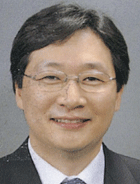
After completing his BS degree at Seoul National University, Youngbin earned his Ph.D. at Michigan in1994. He returned to Seoul to join the faculty and is now a Professor of Mechanical and Aerospace Engineering at Seoul National University. His interests include rocket propulsion and supersonic combustion. He leads one of the important rocket propulsion research labs in Korea and is active in the propulsion research community.

Dave did his undergraduate and graduate work at Michigan, receiving his Ph.D. in 1994. He is now an energy engineer at Siemens Building Technologies in Plymouth MI. He has served as the chapter president of AEE, the Association of Energy Engineers.

After receiving his Ph.D. from Michigan in1992, Bill joined the faculty of North Carolina State University, Department of Mechanical and Aerospace Engineering. His long-term goal is to help solve our global warming and environmental problems through the development and advancement of unique and clever combustion, propulsion and bio-fuel solutions. Presently, he is 1) working on unsteady propulsion systems for high-speed/small-scale unmanned aerial vehicles, 2) developing methods for the conversion of vegetable and algal oils and animal fats into jet fuel and high-octane gasoline, and 3) is studying soot (particulate) formation, morphology and toxicology. Outside of work, Dr. Roberts enjoys restoring classic BMWs and studying the martial arts. He has 5 children so there's never a dull moment.

Sejin come from Seoul National University and completed his Ph.D. at Michigan in 1991 (co-advised with G.M. Faeth). He is now an Associate Professor of Aerospace Engineering at KAIST in Korea. Recently he developed a small rocket thruster for a small satellite. The thruster is mounted directly on the satellite by integrating catalytic reactor and propellant supply technology.

After completing his Ph.D. in 1991, Ming Shin did a post doc with Professor Paul Ronney at USC. He worked on microgravity combustion, and then moved to Case Western University to conduct microgravity combustion research at NASA Glenn. He now is employed at the Aerospace Corporation in Torrance CA.

Doug completed his Ph.D. thesis in 1990 and then did a post doc in Rouen, France. He then joined the faculty at the University of Alabama, Huntsville where he collaborated with NASA Marshall on several rocket propulsion related research projects. He later left to accept the position of Aerospace Engineer at NASA Glenn Research Center where he is currently located. He has been active in the microgravity combustion research program as well as current NASA propulsion projects.

Ruey finished his Ph.D. work in 1988 then did a post-doc at Princeton University with Professors Ronney and Law. He then joined the faculty at the University of Central Florida in Orlando, where he is now a Professor of Mechanical, Materials and Aerospace Engineering. His interests are: phase change heat transfer, fire retardation of composite materials, combustion, propulsion, pollutant emission, nano-particle/fluid suspensions, laser and optical methods.

After completing his Ph.D. 1986 Venkat did post-doc work at UC San Diego and then joined General Atomic in San Diego. He later moved to join GE Global Research and Development near Albany NY where he is currently performing advanced CFD computations. His interests include gas turbine combustors, low NOx, improved mixing designs, and pulsed detonation engines.

Anil studied at IIT Kanpur before completing his Ph.D. work at Michigan in 1986. He was a research engineer at GE Global Research and Development near Albany NY and later took a position and the combustion technology manager at Siemens Gas Turbine Division in Orlando Florida.

Tzong received his Ph.D. 1983 and started a successful research company called TaiTech in Dayton Ohio. It continues to be one of the major consulting companies that interacts with AFRL at Wright-Patterson AFB.